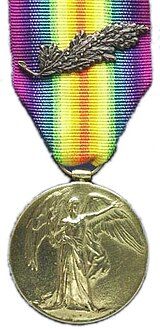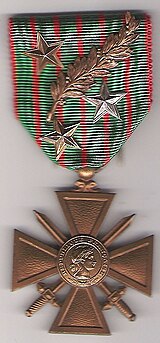Mentioned in dispatches
To bementioned in dispatches(ordespatches,MiD) describes a member of the armed forces whose name appears in an official report written by a superior officer and sent to the high command, in which their gallant or meritorious action in the face of the enemy is described.
In some countries, a service member's name must be mentioned in dispatches as a condition for receiving certain decorations.
United Kingdom, British Empire and Commonwealth of Nations
[edit]United Kingdom
[edit]
Servicemen and women of theUnited Kingdomor theCommonwealthwho are mentioned in despatches (MiD) are not awarded a medal for their actions, but receive a certificate and wear an oak leaf device on the ribbon of the appropriate campaign medal. A smaller version of the oak leaf device is attached to the ribbon when worn alone.[1]Prior to 2014, only one device could be worn on a ribbon, irrespective of the number of times the recipient was mentioned in despatches.[2]Where no campaign medal is awarded, the oak leaf is worn directly on the coat after any medal ribbons.[3]In theBritish Armed Forces,the despatch is published in theLondon Gazette.[1]
Prior to 1914, no decoration existed to signify a mention in despatches, although sometimes a medal for gallantry could be awarded in its place.[1]
For 1914–1918 and up to 10 August 1920, the device consisted of a spray of oak leaves in bronze worn on the ribbon of theVictory Medal.[2]Those who did not receive the Victory Medal wore the device on theBritish War Medal.[4]Established in 1919, it was retrospective to August 1914. It was not a common honour with, for example, only twenty-five (out of 1,000) members of theRoyal Newfoundland Regimentin the First World War mentioned in despatches.[5]In all, 141,082 mentions were recorded in theLondon Gazettebetween 1914 and 1920.[1]
From 1920 to 1993, the device consisted of a single bronze oak leaf, worn on the ribbon of the appropriate campaign medal, including theWar Medalfor a mention during the Second World War.[1]TheCanadian Armed Forcesstill use the bronze oak leaf device.
Since 1993 changes have been made in respect of United Kingdom armed forces:
For awards made from September 1993, the oak leaf has been in silver.[6]The criteria were also made more specific, it now being defined as an operational gallantry award for acts of bravery during active operations.[7]
From 2003, in addition to British campaign medals, the MiD device can be worn onUnited Nations,NATOandEUmedals.[8]
In a change introduced in 2014, up to three MiD devices may be worn on a single campaign medal and ribbon bar for those with multiple mentions, backdated to 1962. Prior to this change, even if the serviceman was mentioned in despatches more than once, only a single such device was worn.[9]

Prior to 1979, a mention in despatches was one of three awards that could be madeposthumously,the others being theVictoria CrossandGeorge Cross.The 1979 reform allowed all gallantry decorations to be awarded posthumously.[10]
Soldiers can be mentioned multiple times. The British First World War Victoria Cross recipientJohn Vereker,later Field Marshal Viscount Gort, was mentioned in despatches nine times, as was the Canadian generalSir Arthur Currie.[11]The Australian generalGordon Bennettwas mentioned in despatches a total of eight times during the First World War, as was Field MarshalSir John Dill.
Below are illustrations of the MiD device being worn on a variety of campaign medal ribbons:
| Victory Medal | First World War | |
| Naval General Service Medal | Campaign Service (1920–1962) | |
| Army & RAF General Service Medal |
Campaign Service (1920–1962) | |
| War Medal 1939–1945 | Second World War | |
| Korea Medal | Korean War | |
| General Service Medal | Campaign Service (1962–1993) | |
| Vietnam Medal | Vietnam War | |
| Gulf Medal | Gulf War | |
| Silver oak leaf device | Awards since 1993 |
Australia
[edit]Australian service personnel are no longer eligible to be mentioned in dispatches. Since 15 January 1991, when theAustralian Honours Systemwas established, the MiD has been replaced by the Australian decorations: the Commendation for Gallantry and the Commendation for Distinguished Service. Similarly, the equivalents of the MiD for acts of bravery by civilians and by soldiers not engaged with the enemy have also been reformed. The reformed and comprehensive system is now as follows:
- TheCommendation for Gallantryis now the fourth level decoration for gallantry.
- TheCommendation for Brave Conductrecognises acts of bravery carried out by soldiers not directly fighting the enemy and by civilians in war or peace.
- TheCommendation for Distinguished Service,a third level distinguished service decoration, recognises distinguished general service, for exemplary performance in fields such as training, maintenance and administration.[12][13]
| Commendation for Gallantry | |
| Commendation for Brave Conduct | |
| Commendation for Distinguished Service |
Canada
[edit]A mention in dispatches – in French,Citation à l'ordre du jour– gives recognition from a senior commander for acts of brave or meritorious service, normally in the field. The Mention in dispatches is among thelist of awards presented by the governor general of Canada.[15]
India
[edit]Mention in dispatches has been used since 1947, in order to recognize distinguished and meritorious service in operational areas and acts of gallantry which are not of a sufficiently high order to warrant the grant of gallantry awards.[16]
Eligible personnel include allArmy,NavyandAir Forcepersonnel including personnel of theReserve Forces,Territorial Army,Militia and other lawfully constitutedarmed forces,members of theNursing Serviceand civilians working under or with the armed forces.[16]
Personnel can be mentioned in dispatches posthumously and multiple awards are also possible. A recipient of a mention in a dispatch is entitled to wear an emblem, in the form of a lotus leaf on the ribbon of the relevant campaign medal. They are also issued with an official certificate from theMinistry of Defence.[16]
Pakistan
[edit]Under the current Pakistani military honours system, theImtiazi Sanadis conferred upon any member of thePakistan Armed Forceswho is mentioned in dispatches for an act of gallantry that does not qualify for a formal gallantry award.[17]

South Africa
[edit]In 1920 theMinister of Defenceof theUnion of South Africawas empowered to award a multiple-leaved bronzeoak leaf emblemto all servicemen and servicewomen mentioned in dispatches during theFirst World Warfor valuable services in action. The emblem, which was regarded as a decoration, was worn on the ribbon of theVictory Medal (Union of South Africa).Only one emblem was worn, irrespective of the number of times a recipient had been mentioned.[18]
TheAfrikaansrendition ofmentioned in dispatchesisEervolle Vermelding in Berigte.
In 1943, theUnion Defence Forceconfirmed the availability of the British award, the bronze oak leaf, for acts of bravery, in contact with the enemy, which fell just short of the standard required for the granting of a decoration, or for valuable services not necessarily in immediate contact with the enemy.
The mention in dispatches (MiD) was one of only four awards which could be made posthumously. The others were theVictoria Cross,theGeorge Cross,and theKing's Commendation(South Africa). The oak leaf emblem was worn on the ribbon of theWar Medal 1939–1945.
TheKing's Commendation (South Africa) (1939–45)was denoted by a bronzeKing Proteaflower emblem worn on the ribbon of theAfrica Service Medal,for valuable services in connection with theSecond World War.It could be awarded posthumously and was the equivalent of a mention in dispatches for services rendered away from the battlefield.[18]
The MiD and the King's Commendation (SA) were the only decorations that could be approved by the South African Minister of Defence without reference to the King.[18]
France
[edit]
1 bronze palm
1 silver gilt star
1 silver star
1 bronze star
Since the French Revolution, France has had the custom of declaring deserving citizens or groups to havebien mérité de la Patrie( "well deserved the recognition of the Country" ). This sentiment is continued to this day in the formulation of the citations that accompany medals.
In the French military, mentions in dispatches – or more accurately, mention in orders (citation dans les ordres) – are made by senior commanders, from the level of a Regimental commanding officer to the Commander-in-Chief, in the orders they give to their unit, recognizing the gallantry of an action performed some time before. There are two kinds of mentions: mentions with cross, for bravery in presence of the enemy, and mentions without cross, for bravery not in presence of the enemy.
Mentions with cross
[edit]The citations are given for acts of gallantry by any member of the French military or its allies and are, depending on the degree, roughly the equivalent of the USBronze Star MedalorSilver Starand the UK Mention in Dispatches orMilitary Crossand, formerly, theMilitary Medal.
Mentions made during the two World Wars or colonial conflicts were accompanied with awards of aCroix de Guerreor aCroix de la Valeur Militaire,with attachments on the ribbon depending on the mention's degree: the lowest degree is represented by a bronze star while the highest degree is represented by a bronze palm.
- a bronze star for those who had been mentioned at theregimentorbrigadelevel.
- a silver star for those who had been mentioned at thedivisionlevel.
- a silver gilt star for those who had been mentioned at thecorpslevel.
- a bronze palm for those who had been mentioned at thearmylevel.
- a silver palm represents five bronze ones.
- a silver gilt palm for those who had been mentioned at theFree French Forceslevel (World War II only).
A unit can also be mentioned in dispatches. The unit standard is then decorated with the corresponding Croix. After two mentions, the men of the unit are entitled to wear afourragère.
| First World War | Colonial Wars 1920–1926 | Second World War | Indochina,Madagascar,Korea,Suez Crisis,GulfandKosovo | Tunisia,Algeria,every military operation where TOE Cross is not awarded |
|---|---|---|---|---|
1914–1918 War Cross |
TOE War Cross |
1939–1945 War Cross |
TOE War Cross |
Cross for Military Valour |
Mentions without cross
[edit]Since 2004, mentions for bravery not involving actual combat with the enemy are awarded with a goldMédaille de la Défense nationale(National Defence Medal) and with the same attachments as theCroix de guerre.Before 2004, these mentions were recorded in the service member record, but not recognized with any decoration.
References
[edit]- ^abcdeP E Abbott & J M A Tamplin.British Gallantry Awards.1981.pp. 296–300. Published by Nimrod Dix & Co, London, 1981.ISBN0-902633-74-0
- ^abPeter Duckers.British Gallantry Awards 1855 – 2000.pp. 54–55. Published by Shire Publications, Oxford, 2010.ISBN978-0-7478-0516-8.
- ^"British (Imperial) Mention in Despatches and Queen's Commendation for Brave Conduct".Vietnam Veterans Association of Australia.Retrieved2009-04-24.
- ^Joslin, Litherland and Simpkin.British Battles and Medals.p. 229. Published Spink, London. 1988.
- ^"The Newfoundland Regiment and the Great War: Commendations".The Rooms Corporation of Newfoundland and Labrador.Retrieved5 Aug2017.
- ^"No. 56878".The London Gazette(Supplement). 17 March 2003. p. 3354.
- ^"Medals: campaigns, descriptions and eligibility".Ministry of Defence Medal Office.Retrieved11 June2018.
- ^John Mussell (ed).Medal Yearbook 2015.p. 108. Published by Token Publishing Ltd. Honiton, Devon.
- ^"Honours and Awards in the Armed Forces (JSP 761) (V5.0 Oct 16). Paras 12.02 and 12.19".MoD Joint Services Publication.4 October 2016.Retrieved2018-02-19.
- ^"Recommendations for Honours and Awards 1935 – 1990".The National Archives.Retrieved2009-04-24.
- ^"Obituary of General Sir Arthur Currie, The (London) Times, Friday, December 01, 1933".Retrieved2008-09-15.
- ^"Commendation for Distinguished Service".It's an Honour.gov.au.Australian Government.Retrieved2009-05-27.
- ^"Commendation for Gallantry".It's an Honour.gov.au.Australian Government.Retrieved2009-05-27.
- ^Boyle, James (1918). "Sgt".La Presse.
- ^Canadian Forces Administrative Order 18-4 Recommendations for Canadian Orders, Decorations and Military HonoursArchived2007-03-15 at theWayback Machine
- ^abc"Mention in Dispatches".Indian Army.Retrieved5 October2014.
- ^"Honours and Awards".Pakistan Army. Archived fromthe originalon 2018-06-13.Retrieved2009-06-06.
- ^abcAlexander, EGM; Barron, GKB; Bateman, AJ (1986).South African Orders, Decorations and Medals.Cape Town: Human and Rousseau Publishers. p. 160.ISBN0-7981-1895-4.
